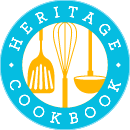Submitted by: Kezia F.
Recipe origin: Southern California
This recipe comes from college senior Kezia, who created a cookbook for Esperenza Community Farms’ CSA boxes. The book informs CSA recipients about the produce they’ve received and gives ideas for how to cook it. If you find yourself with an excess of freshly-harvested onions, here’s how to turn them into stars of the meal, not just supporting characters!
8 onions
7 tablespoons unsalted butter, melted
1/3 cup miso paste
4 cups warm water
Preheat oven to 500°.
Halve the onions lengthwise. In a bowl, whisk together melted butter, miso paste, and warm water. Place the onions cut-side down in a high-sided baking dish and pour in the miso water. Cover and bake for 35 minutes. Turn the onions cut side up, baste well, and bake uncovered for another 45-50 minutes, basting every 10 minutes, until soft and browned.
Ready to turn your recipes into something memorable? Click here to get started!
May 29, 2025 | Posted in:
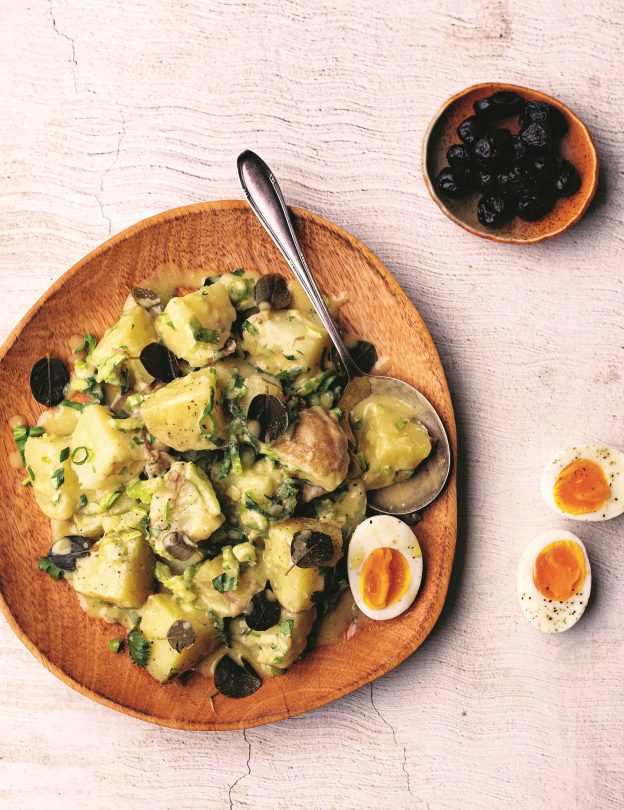
Thanks for Entering the Giveaway!
You’re now entered to win a copy of “My Cypriot Table” by Irene Matys!
Want to double your chances of winning? Follow us on Facebook and Instagram and you’ll be entered again. (If you already follow us, you’re entered twice automatically!)
The contest is open until Wednesday, June 5th, and the winner will be notified by email by Friday, June 7th. In the meantime, Irene has a gift for everyone who enters — her recipe for Warm Potato Salad with Tahini Vinaigrette:
Warm Potato Salad with Tahini Vinaigrette
“There’s nothing like a classic potato salad, but this version elevates it with a twist of Cypriot flavors. The slightly nutty tahini pairs beautifully with the tart lemon and gives it a delicious creamy flavor. This salad pairs wonderfully with any grilled meats, fish, or seafood but I also love it as a meal on its own. It’s just as delicious served cold and taken to a beach or park picnic.”
Salad:
1½ lb (670 g) yellow potatoes, skin on, scrubbed
½ tsp sea salt 4 large eggs
½ cup thinly sliced celery with leaves
⅓ cup finely chop fresh flat-leaf parsley
¼ cup thinly sliced red onions
⅓ cup sun-dried black olives or Kalamata olives, pitted
Lemony Tahini Vinaigrette:
⅓ cup + 1 Tbsp extra-virgin olive oil
3 Tbsp fresh lemon juice 2 Tbsp tahini
1 tsp Dijon mustard
1½ Tbsp pickled capers, drained from their brine
1 tsp sea salt
¼ tsp fresh ground pepper
To make the salad, place the potatoes in a large pot, cover with water, and add the salt. Bring to a boil, then reduce heat to a medium boil. Cook for 20 to 25 minutes or until fork-tender. Drain the potatoes, reserving 3 Tbsp of their water. Cut the potatoes into equal bite-size pieces. Place in a large bowl and toss with the reserved cooking water.
Fill another medium pot with enough water to cover the eggs and bring to a boil. Add the eggs and bring up to a rolling boil for 7 minutes. Drain and put them in an ice bath to cool. Once cool, peel and slice in half lengthwise.
While the potatoes and eggs are cooking, prepare the vinaigrette by whisking the olive oil, lemon juice, tahini, mustard, capers, salt, and pepper in a bowl.
Add the celery, parsley, and onions to the potato salad and toss with the vinaigrette. Serve immediately with the eggs and olives.
May 13, 2025 | Posted in:

Photo Preservation Tips From a Professional Archivist
Sam Rintoul, professional archivist and founder of Mnemosyne Digital shares her top six *Do’s* and *Do Not’s* when it comes to working with and storing your old family photos!
Do – Brief Recordkeeping
Take the minute to write the relevant information on the back of the photograph or to add the metadata in the details section of your digital photograph. This does not have to be extensive, keep it short, sweet and to the point. You may know the who/what/when/where/why right now, but what about in 30-50 years? Think about those details for the person who will be inheriting your collection and wishing they knew the names or locations. Future-you will be grateful that past-you took those few moments to jot anything down to provide context and jog those memories.
Do – Quality Checks
Whether you scrapbook or use photograph albums or store all the photographs in envelopes or boxes, materials matter. Unless the materials are archival quality, the paper used to print, attach or contain the photographs typically contains properties such as lignin which leads to acidity over time. Take a piece of paper and tear a piece off anywhere. Those tiny and frayed fibrous edges that you just created? Regardless of what the material was that created the paper, the cellulose in those fibers is what is going to eventually break down into what is known as lignin which is acidic. Think of newspaper clippings that yellowed with age or were extremely brittle. When you find archival quality materials that say “lignin free” and “buffered” it means that the lignin has already been removed and that there is a layer added to reduce the pH which then reduces the potential of acidity.
Do – Think About How You Handle Photographs
All photographs have emulsion layers. Essentially, an emulsion layer is a thin, light-sensitive layer that captures an image when exposed to light. If we touch the face of a photograph, the natural oils and salts in our skin can leave residue behind as shiny spots and smudges, or cause reactions with the emulsion layer or the backing which can lead to discoloration, fading and degradation. Many of you may have older photographs, maybe even tintypes or daguerreotypes. These have a fragility to them and other chemical compositions that modern photographs do not possess. When handling any photographs, regardless of age, if you do not have any gloves handy, try to hold the photographs only by the edges or let them rest flat on your hand. If you do wear gloves, nitrile (or similar) is the best for photographs. Cotton gloves can impede movement and catch on the edges as well as cause loose fibers and dust to transfer from the gloves to the photographs. If you know you will be handling photographs with your hands, washing your hands thoroughly right beforehand will help remove any excess oil.
Do Not – Underestimate Temperature
Do not underestimate the role temperature can play in wreaking havoc on your photograph collection. Take a moment to think about how/where you store your photograph collection. Many times, photographs are in uninsulated attics, basements or storage units so it is a constant swing of extreme temperatures, cold to hot and back to cold year after year. Heat causes things to expand and cold to contract thus affecting things on a molecular level. Depending on the climate where you live (and other factors such as moisture), this can lead to different and varying forms of damage such as warping, brittleness, even mold. Keeping the photographs in an insulated, temperature-controlled area will lead to max long-term stability for your collection.
Do Not – Treat Your Photographs as if an Office Supply Store Aisle Exploded All Over Them
Talk to any archivist and the bane of their existence are photographs and documents that have been taped, stapled, paper clipped, pinned, stickied, glued, rubber banded, written on, laminated, decorated, etc. Most of the materials that are of varying kinds of metal eventually lead to rust which will affect the emulsification, and the varying types of tape and glue generally are acidic and so will begin to eventually break down and if the tape is removed, chances are it has left a residue behind. However if, for example, scrapbooking is your jam, more power to you and a simple suggestion is to consider investing in two copies of the photographs that you include in the scrapbook. That way, one copy remains fresh and free of all potential holes, rust, residue, tape and laminating and then you can do whatever you would like to the other copy.
Do Not – Store Photographs on the Ground
Unfortunately, storing boxes of photographs on the ground is an all too common occurrence. Long term moisture absorption, bugs, dust, mice, they all can be issues in their own way but all of that pales in comparison to the threat of flooding. Be it from a natural occurrence or the sprinklers being activated, standing water can easily ruin a photographic collection in a very short amount of time. Even if the shelf is not very high off the ground, the guaranteed benefits far outweigh the cons of not elevating the collection at all.
Conclusion
Above all, do not forget to have fun and be in the moment. Collecting and preserving family/chosen-family/friends memories should be an enjoyable experience. When it comes to preservation, something is better than nothing and any step forward, no matter how small, is still a step in the right direction. So have fun and go preserve some photographs! Just remember, no matter how much or how little you can do, preservation here and now is far more cost effective for you than conservation and restoration work will be in the future.
More about Sam:
“My path to becoming an archivist began back in 2011 when I volunteered in the Archives at my local community college for a research project and I was hooked. I have always loved history but for me, it is the personal touches and imagining the life connected to that item that drew me in and fed the love. When standing in the Archives, instead of just reading about history on the pages of books, I could touch pieces of history and be a part of continuing the story. Volunteering at my community college turned into Independent Study classes and work-study opportunities in the Archives and independent contractor work on grant projects at the local museum as an undergraduate student and finally, after completing my Master’s degree in Archival and Records Administration, I began my own Digital Archiving business two years ago this last April. This journey has not been without significant challenges, and I would not be where I am today without the love and support of my partner (who, incidentally, was the other volunteer on that research project in the community college archives). It is because of those challenges that I have come as far as I have today and it is in working with my clients, in learning who they are and essentially touching their memories while I digitize their life stories, that I play a small part in preserving the past for the future.”
Ready to turn your recipes into something memorable? Click here to get started!
May 12, 2025 | Posted in:
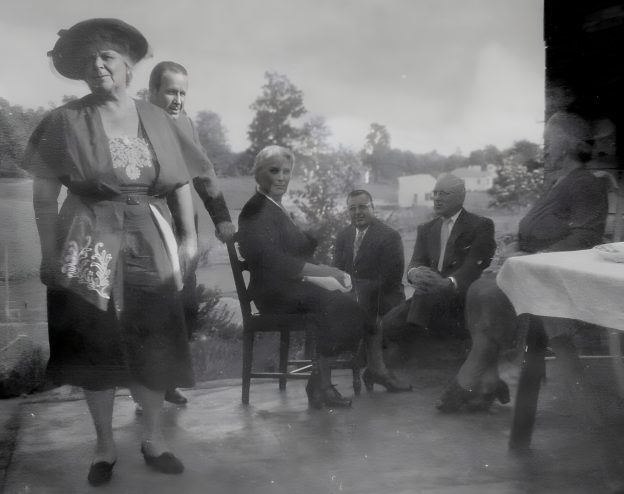
Susie’s Spoon Bread
Submitted by: Bonnie B.
Recipe origin: Southern United States
“When Nana was a little girl, she would often visit Aunt Sis and her husband, Millard Robert Ford (called “Unks”). They lived on Old Court Road in Pikesville adjoining the Suburban Golf Course. The house is no longer there. In the summer, Aunt Sis would make lemonade to sell to the golfers along with delicious homemade ice cream.
Nana lived with Aunt Sis for several years during her teenage years. While living there, Nana worked for the telephone company starting in 1926. Years later, after Unks died, Aunt Sis moved to Ocean City, where we visited
her many times. She died in 1975 at the age of 85. The following recipe was one of her favorites. It was a prize-winning recipe that was given to her many years before.”
1 heaping tbsp. butter
3 pts. (6 c.) boiling water
1 heaping tbsp. Crisco
1 pt. (2 c.) cornmeal
1 tsp. salt
2 eggs, well beaten
1. Preheat oven to 350°.
2. Put the butter into a baking dish (casserole dish) and place in oven for dish
to get hot.
3. Bring water and Crisco to a boil.
4. Stirring briskly, mix in cornmeal and salt until all lumps have disappeared.
5. Mix in 2 well-beaten eggs.
6. Pour into hot baking dish and bake about 30 minutes or until it appears as a
well-browned custard.
7. Serve hot.
Ready to turn your recipes into something memorable? Click here to get started!
March 17, 2025 | Posted in:
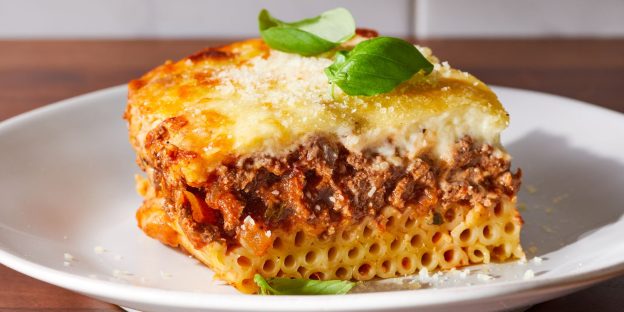
Pastitsio II (Baked Macaroni with Meat)
Submitted by: The Ladies Philoptochos Society of Saint Sophia
Recipe origin: Greece
“The Ladies Philoptochos Society of Saint Sophia would like to share with you our Pastitsio II (Baked Macaroni with Meat) recipe that appears on page 117 of our cookbook. The recipe was introduced by renowned Greek Chef Nicholas Tselementes in the mid-1930’s who converted a very old recipe of a pasta and meat pie wrapped in phylo into a hearty, delicious casserole of layers of pasta, meat, cheeses and bechamel sauce. This is a version of his recipe. Since it’s publication, pastitsio has graced countless family dinners, party buffets, Greek festival and restaurant menus. You will enjoy making this tasty yet simple to make dish.”
Meat Mixture:
2 lb ground beef
1 large onion, chopped
1 stick (½ cup) butter
2 Tbsp tomato paste
1 Tbsp allspice
Salt and pepper to taste
Macaroni:
1 lb (No. 4) macaroni
1 stick (½ cup) melted butter
¾ lb grated Romano cheese
Crema Sauce:
5 cups milk
5 eggs, beaten
1 cup milk, mixed with 5 Tbsp cornstarch
2 Tbsp butter
Prepare the Meat Mixture:
In a pan, sauté the onion in 1 stick of butter until softened.
Add the ground beef and brown well.
Stir in the tomato paste, allspice, salt, and pepper.
Simmer for about 20 minutes until thickened. Set aside.
Prepare the Crema Sauce:
In a saucepan, bring 5 cups of milk to a simmer, stirring constantly.
Before it reaches a boil, slowly stir in the milk-cornstarch mixture.
As the sauce thickens, gradually add the beaten eggs while stirring continuously.
Once thickened, remove from heat and set aside.
Cook the Macaroni:
Boil the macaroni according to package directions, making sure not to overcook. Drain.
Mix the drained macaroni with ½ pound of grated cheese, 1 stick of melted butter, and 1 cup of the prepared Crema Sauce.
Assemble the Pastitsio:
Preheat the oven to 350°F (175°C).
Butter a 10″ x 15″ baking dish.
Spread half of the macaroni mixture in the dish and sprinkle with cheese.
Evenly distribute the meat mixture over the first macaroni layer, then sprinkle with more cheese.
Add the remaining macaroni mixture and sprinkle with more cheese.
Pour the remaining Crema Sauce over the top.
Bake:
Bake at 350°F for 45 minutes or until golden brown.
Let cool slightly, cut into portions, and serve.
Enjoy! 🍽️
Ready to turn your recipes into something memorable? Click here to get started!
March 14, 2025 | Posted in:
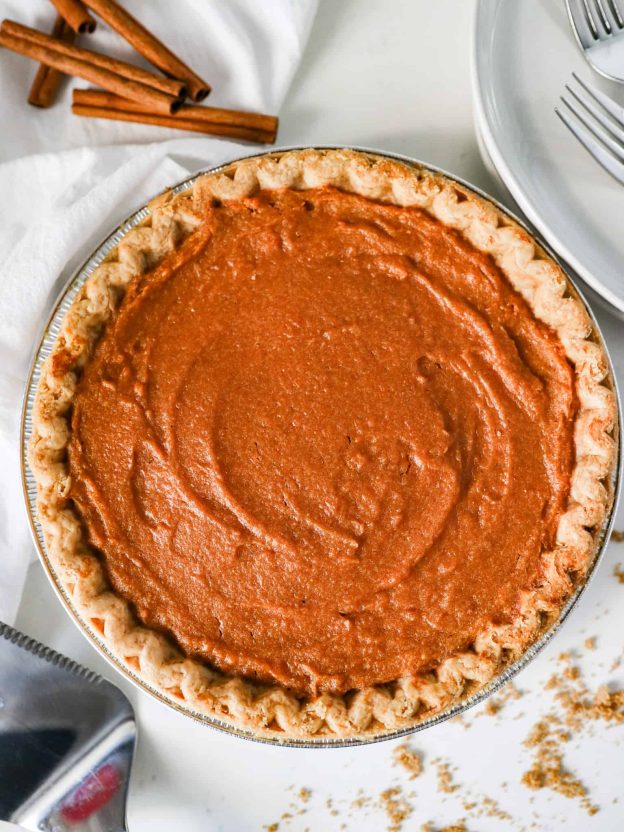
Bobbie’s Sweet Potato Pie – A Classic Recipe for Pi Day
Submitted by: Regina T.
Recipe origin: Southern Cuisine
Pi Day (March 14th) is a celebration of the mathematical constant π (pi), but let’s be honest – it’s also the perfect excuse to indulge in a delicious slice of pie! What better way to mark the occasion than with a comforting homemade recipe that has been passed down through generations?
This Sweet Potato Pie is a true classic, rich with warm spices and a buttery, smooth texture that makes every bite a taste of home. Whether you’re celebrating Pi Day or just craving something comforting and delicious, this recipe is sure to become a favorite!
1 pound sweet potatoes (baked)
1 stick butter
1 cup sugar
2 eggs
1/2 teaspoon nutmeg
1/8 tsp cinnamon
1 teaspoon vanilla extract
1/2 cup evaporated milk
1 (9-inch) deep dish pie shell
Preheat your oven to 350°F (175°C). Prick the pie shell with a fork several times to prevent air pockets from forming. In a mixing bowl, mash the baked sweet potatoes until smooth. Add the butter and mix well. Stir in the sugar, eggs, nutmeg, cinnamon, vanilla extract, and evaporated milk. Mix until fully combined. Pour the mixture into the prepared pie shell. Bake for 1 hour, or until the pie is golden brown and set in the center. Let cool before serving. Enjoy!
Ready to turn your recipes into something memorable? Click here to get started!
March 13, 2025 | Posted in:

David’s Seafood Gumbo
Submitted by: David J.
Recipe origin: Louisiana / West Virginia
In Louisiana, we often say “There are as many recipes for gumbo as cooks that make it.” There are many recipes for gumbo that mix seafood and meat (e.g. shrimp and andouille). I would never tell someone else that they were doing it wrong, but I strongly believe that meats overpower the delicate flavors of seafood and am adamant that the best gumbos are pure seafood.
1 pound (35-count) shrimp, peeled
1 pound jumbo lump crabmeat
2 dozen shucked oysters, reserve liquid
4 jumbo crabs
3 quarts shrimp or crab stock
1 stick of butter
1 cup flour
4 cups frozen okra
2 cups chopped onions
1 cup chopped celery
1/2 cup chopped bell pepper
1/4 cup diced garlic
2 cups sliced green onions
1/2 cup chopped parsley
salt and cayenne pepper
Crystal Hot Sauce
In an 8-quart Dutch oven, heat butter over medium-high heat. Sprinkle in
flour and, using a wire whisk or roux spoon, stir constantly until brown Creole
roux is achieved. Do not allow roux to scorch. When golden brown, reduce
heat to simmer and sauté okra approximately fifteen minutes. Add onions,
celery, bell pepper and garlic and sauté approximately 3-5 minutes until
vegetables are wilted. Add claw crabmeat and stir into roux. Slowly add
shellfish stock, a little at a time, stirring constantly until it is incorporated. Add
the gumbo crabs and bring to a low boil, reduce to simmer, and cook
approximately 30-45 minutes to cook the vegetables. Add additional stock if
necessary to retain volume. Add green onions and parsley. Season to taste
using salt, pepper and Crystal. Fold shrimp, lump crabmeat, oysters and
reserved oyster liquid into soup. Return to a low boil and cook approximately 5
minutes. Adjust seasonings and serve with cooked rice.
Ready to turn your recipes into something memorable? Click here to get started!
March 12, 2025 | Posted in:

David’s Chicken & Sausage Gumbo
Submitted by: David J.
Recipe origin: Louisiana / West Virginia
Until my daughters went away to college, we had family dinner almost every night. Cooking brought us all together.
Ingredients:
2 pounds boneless chicken thighs
1 pound smoked sausage
1 cup butter
1 cup flour
2 cups diced onion
1 cup diced celery
1 cup diced bell peppers
¼ cup minced garlic
3 quarts chicken stock
2 cups sliced green onions
½ cup chopped parsley
2 bay leaves
1 tbsp dried thyme
Salt and cracked pepper (this gumbo is pepper with lots of pepper)
Louisiana hot sauce to taste
Filé
Cut the chicken into ½” cubes and the sausage into ½” slices. In an 8-quart Dutch oven, heat butter over medium-high heat. Sprinkle in flour and, using a wire whisk or roux spoon, stir constantly until brown (or dark brown) Cajun roux is achieved. Do not allow roux to scorch. Add onions, celery, bell pepper, and garlic. Sauté 3-5 minutes or until vegetables are wilted. Add chicken stock, a little at a time, stirring constantly until all is incorporated. Add in the chicken and sausage. Bring to a rolling coil, reduce to simmer, and cook approximately 1 hour. Skim any fat or oil that rises to the top of the pot. Add green onions, bay leaves, and thyme. Season to taste using salt, pepper, and hot sauce. Cook an additional 30 minutes or longer if necessary, until chicken is tender and falling apart. Add parsley and adjust seasonings if necessary. Stir in some filé to taste. Serve over hot, steamed white rice.
Ready to turn your recipes into something memorable? Click here to get started!
February 12, 2025 | Posted in:
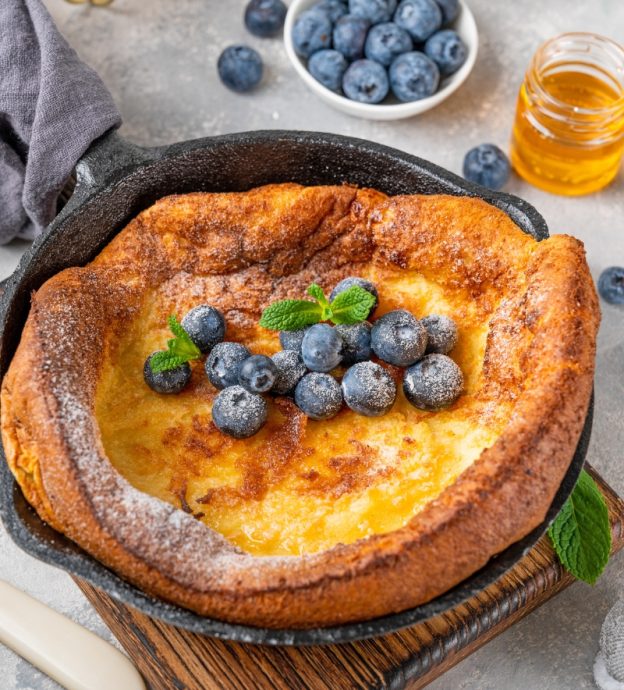
Kristine’s Dutch Baby
Submitted by: Kristine Thompson
Recipe origin: Arizona
My mom made this for us ALL the time! It is definitely one of our very favorites!
Ingredients:
2 eggs at room temperature
1/2 cup milk (preferably whole milk)
1/2 cup flour
2 tablespoons butter
Preheat the oven to 425 degrees on convection bake.
In a vitamix (or blender), add the eggs, milk, and flour. Mix 1-2 minutes until frothy.
In a cast iron pan, melt the butter. Swirl all around the sides of the pan.
Pour batter into the pan. Place in the oven and bake for 11 minutes.
Serve immediately with lemon juice and powdered sugar, or with maple syrup.
Ready to turn your recipes into something memorable? Click here to get started!
January 15, 2025 | Posted in:

Expert Tips for Organizing Your Family Cookbook Project
Is this the year you will finally make that family cookbook you’ve been thinking about for years (or decades)?!
We’re sharing some expert guidance on how to get organized and make it happen in 2025 from Sara Levine Rosenblum of SLR Creative. Sara is a food editor who specializes in helping families, businesses and organizations bring their recipes to life in custom cookbooks.
The first cookbook I created was a celebration of my beloved Grandma Florence’s recipes after she passed away in 2009. Grandma Florence inspired the lifelong love of food and cooking that led me down a path to food writing, culinary school, Food Network and eventually, launching my own business focused on cookbooks!
As you can imagine, I’ve learned a great deal since I published that scrappy little book (at Kinkos!) fifteen years ago, but it still means so much to me and my family.
If you’ve always wanted to celebrate and preserve your recipes in a family cookbook, here are my top 6 tips to get you started:
Give the gift of time.
Want to gift a family cookbook next Christmas? Start now! Spread the word and give everyone (yourself included) plenty of time to gather their recipes.
Get creative with collecting.
Use email and Google Drive folders to gather recipes and photos easily, but don’t forget older relatives who might prefer a phone call. Grandma’s secret recipe might need to be dictated — or better yet, cook it together and document the steps with pictures!
Capture the stories.
Great cookbooks capture memories, not just recipes. When you’ve got relatives on the phone, hit that record button! Jot down personal anecdotes and include them in short headnotes that bring each dish to life.
Make it a team effort.
My mom was my co-editor on Grandma Florence’s cookbook and it was a true bonding experience for us to tackle the project together. Collaborate with siblings, cousins, or parents to create something truly special. Turn that family group chat into a brainstorming session and gift a cookbook everyone will treasure.
Snap and scan.
Take simple photos of dishes at family gatherings – perfect contribution for that amateur photographer on your family “cookbook committee”! Daylight is your best friend for great food photos. Include scans of old recipe cards – the more well-loved, the better – for a nostalgic touch.
Don’t be intimidated.
Platforms like Heritage Cookbook make it seamless to organize, design and print your book. I wish I’d known about Heritage when I was pulling my hair out designing and laying out pages manually for my first Kinkos print job!
January 15th/2025
Ready to turn your recipes into something memorable? Click here to get started!
